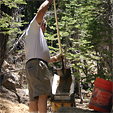All Articles
Legislative and Regulatory Update
November 2000 by Scott Harn
• More National Monument newsWashington (AP)—A 440-square mile sweep of jagged mountains and desert in Southern California would become the country's latest national monument under a recent bill passed in an effort to protect the land from encroaching development.
The unanimous Senate vote sent the bill to President Clinton, who supports the protections in the proposed Santa Rosa and San Jacinto Mountains National Monument.
"The Santa Rosa and San Jacinto Mountains contain magnificent vistas, unique wildlife and a picturesque backdrop that will now be protected and preserved for generations to come," said Sen. Dianne Feinstein, D-Calif.
The monument includes the Santa Rosa Mountains National Scenic Area, part of the San Bernardino National Forest, the state's San Jacinto Wilderness Area and part of the Indian reservation.
Besides general protections for land and wildlife, the bill aims to preserve Indian ceremonial lands and archaeological sites. It would prohibit off-road vehicle use. Mining is banned, but grazing could continue under the bill.
Another bill has passed the U.S. Senate that would prevent development around a 120-mile stretch of the Gold Rush trail across Nevada's Black Rock Desert.
The bill protecting about 1.2 million acres in northwest Nevada heads to the House, where approval is uncertain in the closing days of this congressional session.
"We've cleared a major hurdle, now the challenge is in the House," said Sen. Richard Bryan, D-Nev., the bill's sponsor who is retiring after the session. "I think it's fair to say the odds were long in getting it through this year. This is significant movement."
The Black Rock Desert-High Rock Canyon Emigrant Trails National Conservation Area bill would protect about 800,000 acres administered by the U.S. BLM.
The bill also would designate 11 wilderness areas totaling an additional 400,000 acres.
The bill would prohibit most mining, geothermal activities and new roads across the land. Grazing, hunting and recreational activities could continue on existing roads and trails.
The conservation area roughly fills the "V" formed by Jackson Mountains and Route 34 in the northwestern corner of the state. The designation would protect the portion of the Applegate-Lassen Trail from near Rye Patch Reservoir along Interstate 80 to Vya, Nevada, near the California border.
"This historic trail is an American treasure," said Brian O'Donnell of The Wilderness Society, "Without conservation, dirt-bike trails will spider-web all over the place."
Congress has made 628 wilderness designations covering 104 million acres since the Wilderness Act passed in 1964, but few in the past decade. Congress designated 72,000 acres of wilderness since 1994, according to The Wilderness Society.
By comparison, President Clinton has used the Antiquities Act to withdraw 3.7 million acres since he took office in 1993—the most by any president except Jimmy Carter.
All but one of Nevada's 17 counties opposed the bill at a Senate hearing. A rancher representing the Nevada and California Cattlemen's Associations agreed with trail preservation, but not with conservation for "random, idealistic, science fiction reasons."
As the bill moves to the House, conservationists are looking for supporters to get it approved. "We'll find a horse to ride," said Bart Koehler of The Wilderness Society.
To view the entire bill on the Internet, go to http://thomas.loc.gov and enter bill number S2273.
• Land-use advocates file another suit over National Monuments
Washington (AP)—The Mountain States Legal Foundation and the Blue Ribbon Coalition filed a lawsuit in U.S. District Court challenging that President Clinton over-stepped his authority by putting new restrictions on 1.5 million acres in Arizona, Colorado, Oregon, and Washington state with his national monument designations.
"The bottom line is, the president doesn't have the authority to do what he's done," said William Perry Pendley of the Mountain States Legal Foundation.
Mountain States Legal Foundation already has a pending lawsuit challenging Clinton's 1996 creation of a national monument in Utah.
Spokesmen for the White House and the Interior Department said they had not seen the lawsuit and could not comment on it.
Pendley's group states that in an effort to set aside as much land as possible, Clinton violated the Antiquities Act requirement that monuments "shall be confined to the smallest area compatible with the proper care and management of the objects to be protected."
Clinton cannot use the act to protect features that are not historic, archaeological or scientific sites, Pendley said.
"He has no authority to close these areas because they are pretty, because they have endangered species habitat, because they have wild and scenic rivers or because they have 800-year-old trees," he stated.
• NWMA's Linda Skaer addresses EPA in northern Idaho
The EPA is considering expanding Superfund listings beyond Idaho's Bunker Hill site to include the Spokane River and Lake Coeur d'Alene.
Northwest Mining Association executive director Linda Skaer criticized the EPA at a meeting in northern Idaho.
"Of the billions of dollars the EPA spent on Superfund efforts, only 12 percent have actually gone to cleaning up the environment. The balance went to legal and consulting fees. Superfund was designed for small sites in the chemical industry, not mining sites of relatively low toxicity that may occupy many thousands of acres, or many square miles," stated Skaer.
"The people of northern Idaho and eastern Washington cannot afford to be the pawns of EPA's self-serving manipulations," she stressed.
Skaer's opinion is backed by a 1996 USGS report that concluded that water quality in this area had significantly improved since the mid-'70s, and there is no documented evidence of an adverse impact to the health of residents from trace metals in the Spokane River downstream from Lake Coeur d'Alene.

The Essentials of Dry Washing
 Most dry washers have a feed rate adjustment. It needs to be set so that the material flows evenly over the riffles and does not bury them.
Most dry washers have a feed rate adjustment. It needs to be set so that the material flows evenly over the riffles and does not bury them.
Looking Back
Excerpts from California Mining Journal, our original title, published 50 years ago this month.
The Bawl Mill
• By the numbers...
• National Debt
Goal Setting and Rock Tossing
 Day three was a copy of day two. I started real low in the long wash to see if I could prove how far down the gold had made it.
Day three was a copy of day two. I started real low in the long wash to see if I could prove how far down the gold had made it.
Proposed 100-Mile Road in the Yentna Mining District
A proposed 100-mile road will open up and revitalize the historic Yentna Mining District in Alaska, opening up new areas and opportunities for all in the area.
Mining Stock Quotes and Mineral & Metal Prices
Subscription Required:
The Bawl Mill
• Our Readers Say
• Enrichment of Gold Veins
• The Assay of High Iron Gold Ores
• The Patch
• History of Mining—Bradshaw Mountains, AZ (Part I)
• Picks & Pans—The Green Rock, Rattlesnakes, Good Gold and Ruth's Mine
• The Oretron
• Silver Hill, North Carolina
• Residual, Lateritic and Gossan "Soils" as Potential Nuggetshooting Sites
• Hardrock in Downieville
• Looking Back
• Company Notes
• Gold in Northern Baja California
• California State Gold Panning Championship Results
• Melman on Gold & Silver
• V.P. Contender Addresses Mining Show
Free:








